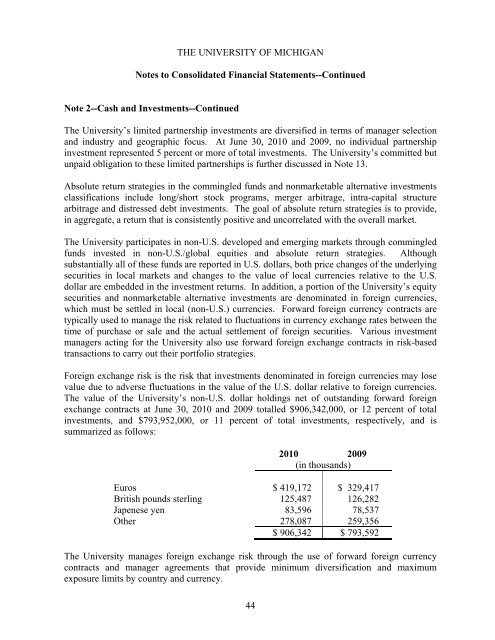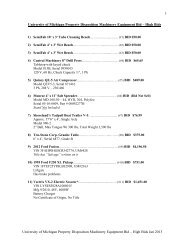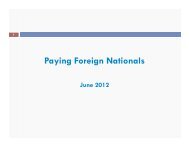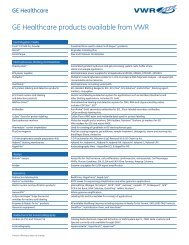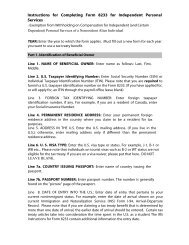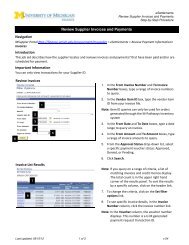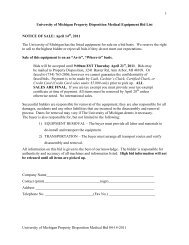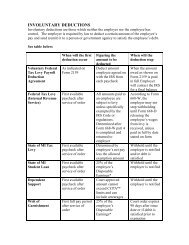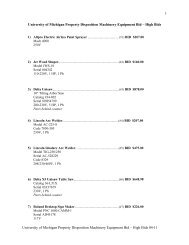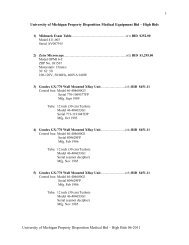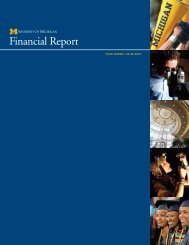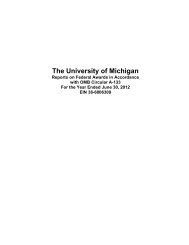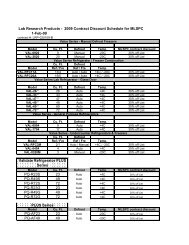2010 A-133 Report - Finance - University of Michigan
2010 A-133 Report - Finance - University of Michigan
2010 A-133 Report - Finance - University of Michigan
Create successful ePaper yourself
Turn your PDF publications into a flip-book with our unique Google optimized e-Paper software.
THE UNIVERSITY OF MICHIGAN<br />
Notes to Consolidated Financial Statements--Continued<br />
Note 2--Cash and Investments--Continued<br />
The <strong>University</strong>’s limited partnership investments are diversified in terms <strong>of</strong> manager selection<br />
and industry and geographic focus. At June 30, <strong>2010</strong> and 2009, no individual partnership<br />
investment represented 5 percent or more <strong>of</strong> total investments. The <strong>University</strong>’s committed but<br />
unpaid obligation to these limited partnerships is further discussed in Note 13.<br />
Absolute return strategies in the commingled funds and nonmarketable alternative investments<br />
classifications include long/short stock programs, merger arbitrage, intra-capital structure<br />
arbitrage and distressed debt investments. The goal <strong>of</strong> absolute return strategies is to provide,<br />
in aggregate, a return that is consistently positive and uncorrelated with the overall market.<br />
The <strong>University</strong> participates in non-U.S. developed and emerging markets through commingled<br />
funds invested in non-U.S./global equities and absolute return strategies. Although<br />
substantially all <strong>of</strong> these funds are reported in U.S. dollars, both price changes <strong>of</strong> the underlying<br />
securities in local markets and changes to the value <strong>of</strong> local currencies relative to the U.S.<br />
dollar are embedded in the investment returns. In addition, a portion <strong>of</strong> the <strong>University</strong>’s equity<br />
securities and nonmarketable alternative investments are denominated in foreign currencies,<br />
which must be settled in local (non-U.S.) currencies. Forward foreign currency contracts are<br />
typically used to manage the risk related to fluctuations in currency exchange rates between the<br />
time <strong>of</strong> purchase or sale and the actual settlement <strong>of</strong> foreign securities. Various investment<br />
managers acting for the <strong>University</strong> also use forward foreign exchange contracts in risk-based<br />
transactions to carry out their portfolio strategies.<br />
Foreign exchange risk is the risk that investments denominated in foreign currencies may lose<br />
value due to adverse fluctuations in the value <strong>of</strong> the U.S. dollar relative to foreign currencies.<br />
The value <strong>of</strong> the <strong>University</strong>’s non-U.S. dollar holdings net <strong>of</strong> outstanding forward foreign<br />
exchange contracts at June 30, <strong>2010</strong> and 2009 totalled $906,342,000, or 12 percent <strong>of</strong> total<br />
investments, and $793,952,000, or 11 percent <strong>of</strong> total investments, respectively, and is<br />
summarized as follows:<br />
44<br />
<strong>2010</strong> 2009<br />
(in thousands)<br />
Euros $ 419,172 $ 329,417<br />
British pounds sterling 125,487 126,282<br />
Japenese yen 83,596 78,537<br />
Other 278,087 259,356<br />
$ 906,342 $ 793,592<br />
The <strong>University</strong> manages foreign exchange risk through the use <strong>of</strong> forward foreign currency<br />
contracts and manager agreements that provide minimum diversification and maximum<br />
exposure limits by country and currency.


